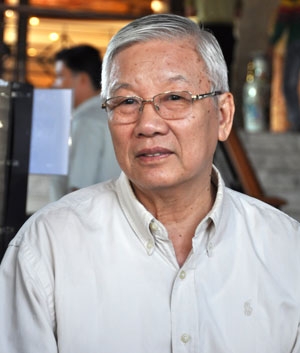 Economy
Economy

 |
| Prof. Dr. Sc. Hồ Sĩ Thoảng |
Prof. Dr. Sc. Hồ Sĩ Thoảng, former Chairman of Board of Directors of the Vietnam National Oil and Gas Group (Petrovietnam), engaged in a discussion with Năng Lượng Mới (Vietnam Energy) Magazine, addressing a range of compelling topics concerning energy. These discussions encompassed the future trajectory of Việt Nam's oil and gas sector given the ongoing energy transition, the movement towards curbing fossil fuel consumption and the surge in renewable energy adoption.
What are your thoughts on the global energy transition trend, and how do you see the future of the oil and gas industry?
The world is shifting from traditional energy sources to renewables to reduce CO2 emissions. The goal is balanced emissions and recovery, using methods like CO2 capture and conversion into chemicals or fuel. Hydrogen is the only fuel that doesn't emit CO2 upon burning, presenting a promising avenue. The "Hydrogen Economy" concept was introduced decades ago, but technical challenges (storage and transport) hindered its adoption. Now, with technology advancements, the opportunity is ripe.
At the beginning of the 21st century, Hungarian-American chemist George A. Olah, who was awarded a Nobel Prize in Chemistry in 1994, introduced the "Methanol Economy" theory involving the usage of CO2 emissions to create methanol, which can be turned into gasoline, diesel, or fuel. The emitted CO2 from methanol combustion can be recaptured and converted back into methanol using hydrogen. This points toward a future with reduced CO2 emissions and reduced reliance on oil and coal.
However, the challenge lies in sourcing hydrogen. Water is abundant in hydrogen, but extracting it demands energy. While solar and wind energy can potentially electrolyse water into hydrogen, their high costs and intermittent nature are drawbacks. Global efforts are underway to optimise these renewable sources and reduce their costs.
Historically, hydrogen has predominantly been derived from fossil fuels, resulting in CO2 emissions — an undesirable outcome.
By 2022, huge investments worth billions of dollars went into renewable energy. China leads, investing around US$150 billion in solar and $70 billion in wind, equivalent to 55 per cent of global investments. The US and Europe follow, with Germany in the lead in Europe.
Beyond wind and solar, another investment path is CCUS (carbon capture, utilisation and storage). It's promising but faces technical hurdles.
Biofuels are also emerging, yet their growth is slow due to competition with food production (traditional biofuels, like gasoline or biodiesel, are derived from edible materials or crops cultivated on arable land).
Notably, second-generation biofuels from various biomass sources are gaining traction. Various types of waste, including agricultural, forestry, industrial, municipal waste, wastewater and plantation forests, are employed to create second-generation biofuels using methods like fermentation, pyrolysis and gasification.
In a notable initiative, the Vietnam Petroleum Institute, in collaboration with a German research institute, has adopted pyrolysis technology. This project converts agricultural biomass like corn cobs and rice straw into fuel. Initially, the biomass undergoes conversion into a compound called bio-oil, which contains some oxygen but remains suitable for agricultural machinery use. This approach holds potential for smaller nations like Viêt Nam.
These options align with the "zero carbon" trend and offer long-term investment opportunities.
According to the International Energy Agency, over 50 per cent of oil and gas reserves are controlled by national companies and governments, not private firms. This pressures oil and gas companies globally, pushing them to balance short-term profits with long-term development or face elimination.
Concerns have been raised regarding the availability of high-quality human resources in the initial stages. What are your thoughts?
Our team possesses exceptional experts proficient in foreign languages and technical skills comparable to international counterparts. Petrovietnam's technical and managerial team stands out.
Over time, Việt Nam's oil and gas workforce has transformed. For instance, in 1994, we lacked the capability to drill deep exploration wells, necessitating foreign rig borrowing and expert hiring. Today, PTSC manages tasks like rig transportation, installation and commissioning autonomously. Foreign companies willingly employ PTSC engineers at annual salaries reaching hundreds of thousands of dollars. PVEP, PVTrans and PTSC personnel also excel.
Dung Quất Oil Refinery's State award exemplifies rapid advancements in factory management, technology, safety, capacity and energy efficiency. Constraints persist in our mechanism, but a resolute and innovative approach is imperative. People are pivotal, with science and technology as supplementary components.
I believe Vietnamese potential matches any nation's; practice, learning, cooperation and foreign partnerships are key. Collaborating with risk-takers in biotech, hydrogen and novel uncommercialised projects is essential. Amid the energy transition, Petrovietnam's research units must harness global knowledge for local applications. Therefore, emphasis on diverse training is crucial.
Petroleum human resources shine, yet continuous learning is fundamental. Harmonised efforts among Petrovietnam's scientists foster innovative outcomes.
How can the oil and gas industry, including Petrovietnam, ensure sustainable development?
Initially, we should continue both domestic and international operations. The global reservoirs of oil and gas remain intact, thus warranting our ongoing efforts. When it comes to ventures overseas, it's imperative to draw from the triumphs of past projects as we forge ahead. Entities like PTSC, PVTrans, and PV Drilling have the potential to collaborate with international partners and diversify. Revisions to the Petroleum Law offer a favourable legal framework.
In the next phase, we must carefully transition some oil refining to petrochemicals. Dung Quất Oil Refinery sets an example by boosting olefin production and innovating products. This shift is underway. The base of this sector is olefins and aromatic compounds. While 10 per cent of global oil is converted to petrochemicals, 90 per cent remains as fuel. Demand for petrochemical goods rises with modern living.
However, the refining-to-petrochemicals shift requires a gradual and determined approach, finding cost-effective solutions. This is Petrovietnam's key task. It calls for science, skilled individuals and projects to create fuel, energy, methanol, diesel and hydrogen. New hydrogen sources, like waste and agricultural residue, should be explored. Such projects might not match renewable energy scales but offer economic benefits worldwide. — VNS